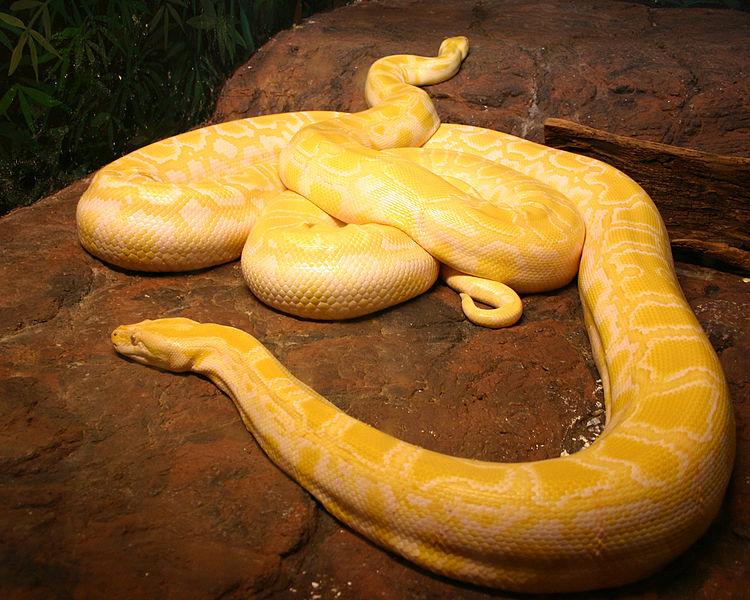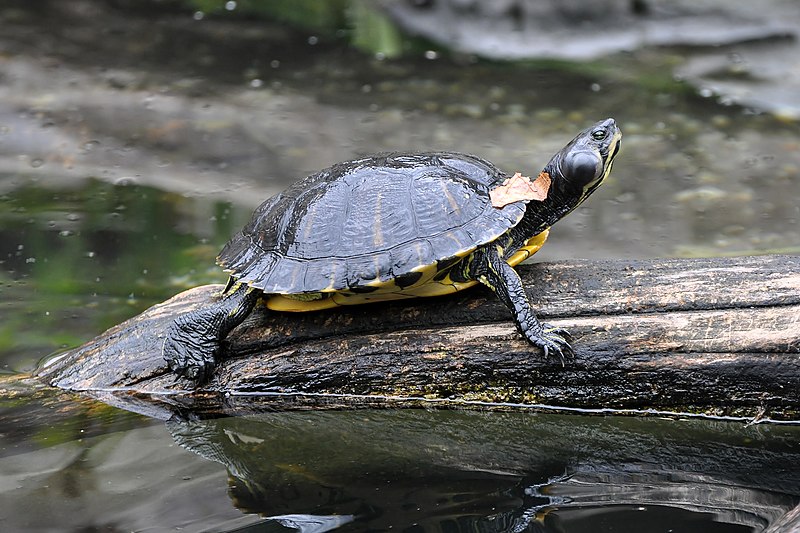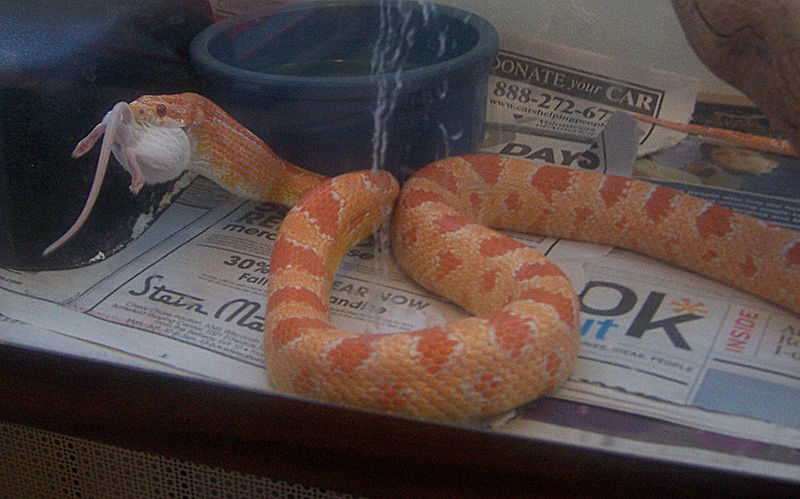 The Burmese or Asian Rock Python, Python molurus bivittatus (or Python bivittatus, see below) is one the world’s longest snakes, and vies with the Green Anaconda for the title of heaviest. Florida’s introduced Burmese Pythons are often in the news these days for causing ecological havoc and occasional human fatalities. However, not much attention is given to this massive serpent’s life in its natural habitat.
The Burmese or Asian Rock Python, Python molurus bivittatus (or Python bivittatus, see below) is one the world’s longest snakes, and vies with the Green Anaconda for the title of heaviest. Florida’s introduced Burmese Pythons are often in the news these days for causing ecological havoc and occasional human fatalities. However, not much attention is given to this massive serpent’s life in its natural habitat.
Description
Matched in size only by the Reticulated Python and Green Anaconda (the heaviest of which I’ve encountered tipped the scales at 215 lbs.), this stoutly-built snake may reach 25 feet in length, although animals of 18-20 feet are considered large.
“Baby”, a huge female in residence at Illinois’ Serpent Safari Park, is said to measure 27 feet in length and weigh 403 pounds (please check out this video). A specimen under my care at the Bronx Zoo exceeded 300 pounds in weight and consumed 30-40 pound pigs with little difficulty. The large albino python has been on exhibit at the Brooklyn Children’s Museum for over 20 years.
The ground color is yellowish-buff or tan fading to cream along the flanks, with large chestnut-brown blotches throughout. There is an arrow-shaped mark on top of the head. A variety of color morphs are common in the pet trade.
Most taxonomists now classify this snake as a distinct species, rather than as a subspecies of the Indian Python.
Range
The Burmese Python ranges widely throughout South and Southeast Asia, including northeastern India, Myanmar, southern Nepal, Thailand, Laos, Cambodia, Vietnam and southern China (including Hainan and Hong Kong). Introduced populations are established in Florida and Puerto Rico. Records from Sumatra and Borneo are likely misidentifications.
The closely-related Indian Python, Python molurus, is found in India, Pakistan, Sri Lanka and Nepal.
Habitat
This snake is extremely adaptable, but requires the presence of a permanent water source. It inhabits wooded grasslands, swamps, open forests, river valleys and rocky foothills. Farms, suburbs and the fringes of urban areas are frequently colonized.
Natural Diet
 All pythons have thermo-receptive sensory pits along the upper jaw that assist in locating warm-blooded animals at night. Prey is killed by constriction, with death resulting due to compression of the lungs and heart failure (via pressure on the heart and blood vessels).
All pythons have thermo-receptive sensory pits along the upper jaw that assist in locating warm-blooded animals at night. Prey is killed by constriction, with death resulting due to compression of the lungs and heart failure (via pressure on the heart and blood vessels).
The range of animals taken is vast. Adults usually concentrate on monkeys, deer (Muntjac, Chital, Hog Deer, Sambar Fawns) wild pigs, Peafowl, Red Jungle Fowl, small cats and other carnivores, and large rodents. Toads, fishes, porcupines, pangolins and monitor lizards are listed as prey in several older field reports.
In his classic book The Giant Snakes (a “must read” for all snake fans!), Clifford Pope reports that a Leopard measuring 4’ 2” long was taken by an 18 foot Burmese Python and that a young captive consumed 61 pounds of rats in one year, thereby adding 34.5 pounds to her weight. The largest meal of which I’m personally aware is a 50 pound pig taken by a captive in theUSA.
Humans and Domestic Animals as Prey
Burmese Pythons, Reticulated Pythons, Green Anacondas and African Rock Pythons are the only constrictors known to have killed people. The reported cases concerning Burmese Pythons involved large pets attacking their owners; in several cases, escapees have attempted to consume children. The other species mentioned have, on rare occasions, preyed upon people in natural (free-living) situations.
In addition to such tragic encounters, pythons also run afoul of people by feeding upon domestic animals. I was once called to Prospect Park, Brooklyn to deal with an escaped pet snake that had consumed a cat (much to the horror of a large crowd of onlookers!). Some years ago, an article in Herpetological Review recounted the story of a python that ate 2 chickens on a farm in China. Upon capture, the snake regurgitated the chickens, which were promptly carted off by their rightful owner. Domestic geese, ducks, goats, sheep, pigs and dogs are also taken on farms and in suburban areas.
Burmese Pythons in Florida are known to take endangered species such as Key Largo Wood Rats. One now famous photo taken in the Everglades depicts a massive individual trying to swallow a large alligator. In Puerto Rico, it is feared that introduced Burmese Pythons will out-compete and prey upon the endangered Puerto Rican Boa.
Please see my article Giant Snake Meals http://blogs.thatpetplace.com/thatreptileblog/2008/04/11/big-snake-meals/ for some personal and recorded observations on this topic (130 pound Impala, Siamese cat belonging to king of former Siam, etc.)
Status
Despite its wide range and adaptability, the Burmese Python is threatened in some regions by habitat loss and by over-collection for the leather and traditional medicine trades. Huge numbers were collected for sale as pets in years past, but most are now captive-born.
 Burmese Pythons are bred in Vietnam for release as rodent control agents, but are killed for preying on domestic animals in other countries. The species is listed on Appendix II of CITES and protected by the government ofIndia.
Burmese Pythons are bred in Vietnam for release as rodent control agents, but are killed for preying on domestic animals in other countries. The species is listed on Appendix II of CITES and protected by the government ofIndia.
Longevity
Captives have lived for over 34 years; unknown in the wild.
Reproduction
Pythons possess a pair of vestigial legs (“spurs”) alongside the cloaca. These are larger in males, and are rubbed along the female’s body during courtship. Mating occurs from January through March, during periods of slightly reduced temperature.
In common with all pythons, the female protects and incubates her eggs. Females engage in a “shivering” motion that can raise their own core temperatures and that of the egg clutch.
Female Burmese Pythons lay 18-100 eggs after a gestation period of 60-150 days. The eggs hatch in 55-75 days. The hatchlings are 18-24 inches long (large enough to consume adult mice) and become sexually mature at a length of approximately 10 feet (males) to 13 feet (females). Under captive conditions, sexual maturity can be attained in 3 years.
Further Reading
Giant Snake Meals
Video: capture of huge python in Florida
The Giant Snakes (Clifford Pope, 1965); don’t miss this classic!
The Green Anaconda: Natural History of the World’s Largest Snake
Range information for all Pythons (40 species)
Burmese Python image referenced from wikipedia and originally posted by Mariluna
Albino Burmese Python image referenced from wikipedia and originally posted by Mike Murphy
 I’ve found the Penn Plax Turtle Pier to be one of the most useful of all basking platforms. In addition to providing a haul-out site that does not take away from the swimming area, it can be used by reptiles and amphibians in a variety of other ways. Today I’d like to describe two “fine points” that are sometimes over-looked when semi-aquatic terrariums are designed.
I’ve found the Penn Plax Turtle Pier to be one of the most useful of all basking platforms. In addition to providing a haul-out site that does not take away from the swimming area, it can be used by reptiles and amphibians in a variety of other ways. Today I’d like to describe two “fine points” that are sometimes over-looked when semi-aquatic terrariums are designed. That Reptile Blog – Reptile, Amphibian and Exotic Pet Care and Information
That Reptile Blog – Reptile, Amphibian and Exotic Pet Care and Information





